Haryana State Board HBSE 10th Class Maths Solutions Chapter 12 Areas Related to Circles Ex 12.3 Textbook Exercise Questions and Answers.
Haryana Board 10th Class Maths Solutions Chapter 12 Areas Related to Circles Ex 12.3
Unless stated otherwise, use π = \(\frac{22}{7}\).
Question 1.
Find the area of shaded region in the given figure, If PQ = 24 cm, PR = 7 cm and O is the centre of the circle.
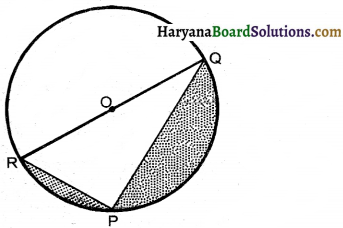
Solution:
We have,
PQ = 24 cm.
PR = 7 cm.
∠QPR = 90° [∵ Angle in a semicircle is 90°]
In right angled ∆RPQ, we have
RQ2 = RP2 + PQ
⇒ RQ2 = 72 + 242
⇒ RQ2 = 49 + 576
⇒ RQ2 = 625
⇒ RQ = √625 = 25 cm
Radius (RO) = \(\frac{25}{2}\) cm
Area of shaded region= Area of semicircle – Area of ∆RPQ
= \(\frac{1}{2}\) πr2 – \(\frac{1}{2}\) × PQ × RP
= \(\frac{1}{2} \times \frac{22}{7} \times \frac{25}{2} \times \frac{25}{2}-\frac{1}{2} \times 24 \times 7\)
= 245.54 – 84
= 161.54 cm2.
Hence, area of shaded region = 161.54 cm2
![]()
Question 2.
Find the area of shaded region in the given figure, if radii of the two concentric circles with centre O are 7 cm and 14 cm respectively and ∠AOC = 40°.
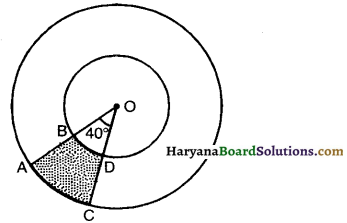
Solution:
We have,
Radii of two concentric circles = 7 cm, 14 cm and ∠AOC = 40°
Area of shaded region = Area of sector AOC – Area of sector BOD
= \(\frac{\pi \times 14^2 \times 40^{\circ}}{360^{\circ}}-\frac{\pi \times 7^2 \times 40^{\circ}}{360^{\circ}}\)
= \(\frac{\pi}{9}\) [142 – 72 ]
= \(\frac{\pi}{9}\) × (14 + 7) (14 – 7)
= \(\frac{22}{7 \times 9}\) × 21 × 7
= \(\frac{154}{3}\) cm2
Hence, area of shaded region = \(\frac{154}{3}\) cm2.
Question 3.
Find the area of the shaded region in the given figure, if ABCD is a square of side 14 cm and APD and BPC are semi-circles.
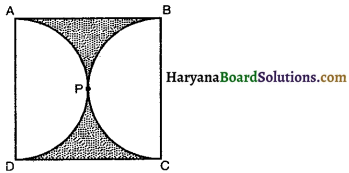
Solution:
We have,
Side of square = 14 cm
radius of semicircle = \(\frac{14}{2}\) = 7 cm
Area of shaded region = Area of square – 2 × Area of semicircle
= 14 × 14 – 2 × \(\frac{1}{2}\) × π × r2
= 14 × 14 – 2 × \(\frac{1}{2}\) × 7 × 7
= 196 – 154 = 42 cm2.
Hence, area of shaded region = 42 cm2.
![]()
Question 4.
Find the area of the shaded region in the given figure, where a circular arc of radius 6 cm has been drawn with vertex O of an equilateral triangle OAB of side 12 cm as centre.
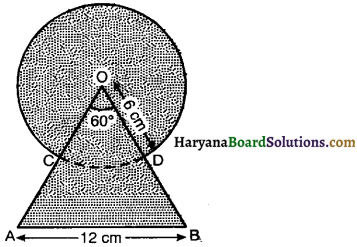
Solution.
We have,
Radius of circle = 6 cm
Side of equilateral triangle = 12 cm
Area of shaded region = Area of circle + Area of equilateral ∆OAB – Area of sector OCD
= π × 62 + \(\frac{\sqrt{3}}{4}\) × (12)2 – \(\frac{60^{\circ}}{360^{\circ}}\) × π × 62
= \(\frac{22}{7} \times 36+\frac{\sqrt{3} \times 144}{4}-\frac{1}{6} \times \frac{22}{7} \times 36\)
= \(\frac{22 \times 36}{7}-\frac{22 \times 6}{7}\) + 36√3
= \(\frac{660}{7}\) + 36√3
Hence, area of shaded region = (\(\frac{660}{7}\) + 36√3) cm2.
Question 5.
From each corner of a square of side 4 cm a quadrant of a circle of radius 1 cm is cut and also a circle of diameter 2 cm is cut as shown in the figure. Find the area of remaining portion of the square.
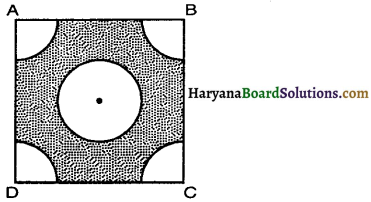
Solution:
We have,
side of the square = 4 cm
Radius of quadrant = 1 cm
and radius of circle = \(\frac{2}{2}\) = 1 cm.
Area of the remaining portioñ of the square = Area of square – (4 × Area of quadrant of circle + Area of circle)
= 4 × 4 – \(\left(4 \times \frac{90^{\circ}}{360^{\circ}} \times \frac{22}{7} \times(1)^2+\frac{22}{7} \times 1^2\right)\)
= 16 – \(\left(4 \times \frac{1}{4} \times \frac{22}{7}+\frac{22}{7} \times 1\right)\)
= 16 – (\(\frac{22}{7}+\frac{22}{7}\))
= 16 – \(\frac{44}{7}\)
= \(\frac{112-44}{7}=\frac{68}{7}\) cm2.
Hence, area of remaining portion = \(\frac{68}{7}\) cm2.
![]()
Question 6.
In a circular table cover of radius 32 cm, a design is formed leaving an equilateral triangle ABC in the middle as shown in the given figure. Find the area of the design.
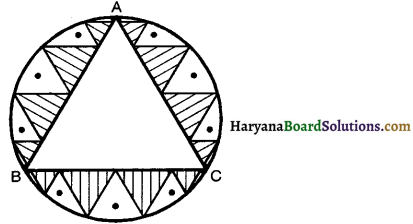
Solution:
We have,
Radius of the circle = 32 cm
O is the centre of the circle
∆ABC is an equilateral triangle.
Join OA, OB and OC.
Now ∠AOB = ∠BOC = ∠COA = 120°
In ∆OBC, we have
OB = OC [Equal radii of circle]
Draw OD ⊥ BC
∆ODB ≅ ∆ODC [By R.H.S. congruence]
⇒ ∠COD = \(\frac{120^{\circ}}{2}\) = 60°. [CPCT]
⇒ \(\frac{\mathrm{BD}}{\mathrm{OB}}\) = sin 60°
⇒ \(\frac{\mathrm{BD}}{32}=\frac{\sqrt{3}}{2}\)
⇒ BD = \(\frac{32 \sqrt{3}}{2}\) = 16√3
⇒ BC = 2 × BD
⇒ BC = 2 × 16√3 = 32√3 cm
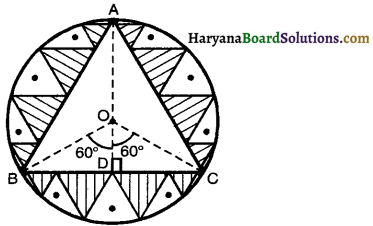
Area of the shaded region (designed) = Area of the circle – Area of the ∆ABC
= πr2 – \(\frac{\sqrt{3}}{4}\) (side)2
= π × (32)2 – \(\frac{\sqrt{3}}{4}\) × (32√3)2
= \(\frac{22}{7}\) × 1024 – √3 × 768
= (\(\frac{22528}{7}\) – 768√3) cm2
Hence, area of the shaded region (designed) = (\(\frac{22528}{7}\) – 768√3) cm2
![]()
Question 7.
In the given figure, ABCD is a square of side 14 cm, with centres A, B, C and D, four circles are drawn such that each circles touch externally two of the remaining three circles. Find the area of the shaded region.
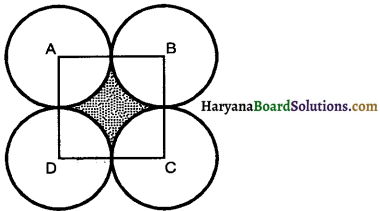
Solution:
We have,
Side of square = 14 cm
Radius of each circle = \(\frac{14}{2}\) = 7 cm
Area of the Shaded region = Area of square – 4 × quadrant area
= (side)2 – 4 × \(\frac{1}{4}\) πr2
= 14 × 14 – 4 × \(\frac{1}{4}\) × \(\frac{22}{7}\) × 72
= 196 – 22 × 7
= 196 – 154 = 42 cm2.
Hence, area of shaded region = 42 cm2.
Question 8.
In the given figure depicts a racing track whose left and right ends are semicircular. The distance between the two inner parallel line segments is 60 m and they are each 106 m long. If the track is 10 m wide, find :
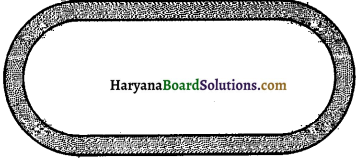
(i) The distance around the track along its inner edge.
(ii) The area of the track.
Solution:
(i)
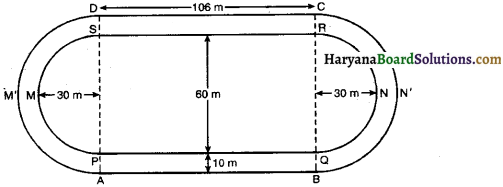
The distance around the track along its inner edge = Perimeter of PMS + PQ + Perimeter of QNR + SR
= (π × 30 + 106 + π × 30 + 106) m
= 212 + 60π
= 212 + 60 × \(\frac{22}{7}\)
= 212 + \(\frac{1320}{7}\)
= \(\frac{1484+1320}{7}\) = \(\frac{2804}{7}\)
(ii) Outer radius = 30 + 10 = 40 m
Area of the track = Area of rectangle PABQ + Area of rectangle DCRS + 2 × Area of semi circular ring
= 106 × 10 + 106 × 10 + 2 × \(\frac{1}{2}\) π(402 – 302)
= 1060 + 1060 + \(\frac{22}{7}\) × (40 + 30) (40 – 30) 22 1
= 2120 + \(\frac{22}{7}\) × 700
= 2120 + 2200 = 4320 m2.
Hence, distance around the track along its inner edge = \(\frac{2804}{7}\) m
area 0f track = 4320 m2.
![]()
Question 9.
In the given figure, AB and CD are two diameters of a circle (with centre O) perpendicular to each other and OD is the diameter of the smaller circle. If OA = 7 cm, find the area of the shaded region.
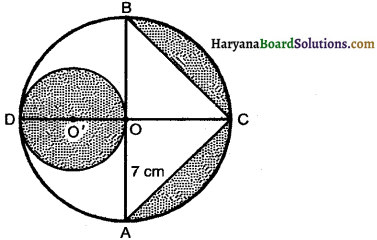
Solution:
we have,
OA = 7 cm.
∴ AB = CD = 2 × 7 = 14 cm
OC = OB = OA = OD = 7 cm
diameter AB ⊥ diameter CD
Radius of smaller circle having centre = \(\frac{7}{2}\) cm.
Area of shaded region= Area of smaller circle having centre 0′ + (Area of semicircle ACB – area of ∆ABC)
= \(\pi \times\left(\frac{7}{2}\right)^2+\left[\frac{1}{2} \pi \times(7)^2-\frac{1}{2} \times 14 \times 7\right]\)
= \(\frac{22}{7} \times \frac{49}{4}+\left[\frac{1}{2} \times \frac{22}{7} \times 49-49\right]\)
= 38.5 + [77 – 49]
= 38.5 + 28 = 66.5 cm2.
Hence, area of the shaded region= 66.5 cm2.
Question 10.
The area of an equilateral triangle ABC is 17320.5 cm2. With each vertex of the triangle as centre, a circle is drawn with radius equal to half the length of the side of the triangle (see in figure). Find the area of the shaded region. (use π = 3.14 and √3= 1.73205)
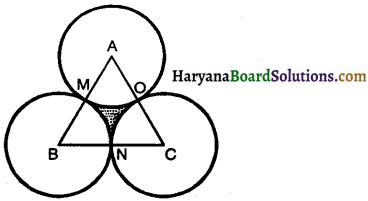
Solution.
Let the side of equilateral ∆ be x cm.
Area of equilateral triangle = \(\frac{\sqrt{3}}{4}\) × x2
⇒ 17320.5 = \(\frac{\sqrt{3}}{4}\) × x2
[given, area of triangle = 17320.5 cm2]
⇒ 17320.5 × 4 = √3x2
⇒ x2 = \(\frac{17320 \cdot 5 \times 4}{\sqrt{3}}\)
⇒ x2 = \(\frac{17320 \cdot 5}{1 \cdot 73205}\) × 4
⇒ x2 = 10000 × 4
⇒ x2 = 40000
⇒ x = \(\sqrt{40000}\) = 200 cm.
Then, radius of each circle = \(\frac{200}{2}\) = 100 cm
Area of shaded region = Area of ∆ABC – (Area of sector AMO + Area of sector BMN + Area of sector CNO)
= 17320.5 – \(\left(\frac{60^{\circ}}{360^{\circ}} \times \pi \times(100)^2+\frac{60^{\circ}}{360^{\circ}} \times \pi \times(100)^2+\frac{60^{\circ}}{360^{\circ}} \times \pi \times(100)^2\right)\)
= 17320.5 – [3 × \(\frac{1}{6}\) × π × (100)2]
= 17320.5 – \(\frac{\pi}{2}\) × 10000
= 17320.5 – \(\frac{3.14}{2}\) × 10000
= 17320.5 – 15700 = 1620.5 cm2.
Hence, area of shaded region = 1620.5 cm2.
![]()
Question 11.
On a square handkerchief, nine circular designs each of radius 7 cm are made (see in figure). Find the area of the remaining portion of the handker-chief.
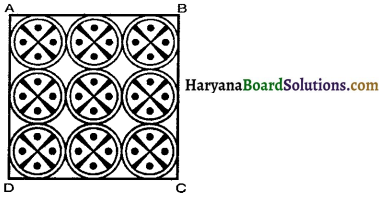
Solution.
We have,
radius of circle = 7 cm
Diameter of the circle = 2 × 7 = 14 cm
Side of the square ABCD = 3 × 14 = 42 cm
Area of the remaining portion of handkerchief = Area of square ABCD – 9 × area of circle
= 42 × 42 – 9 × π × 72
= 1764 – 9 × \(\frac{22}{7}\) × 7 × 7
= 1764 – 1386
= 378 cm2.
Hence, area of the remaining portion of handkerchief = 378 cm2.
Question 12.
In the given figure, OACB is a quadrant of a circle with centre 0 and radius 3’5 cm. If OD = 2 cm, find the area of the :
(i) Quadrant OACB
(ii) Shaded region
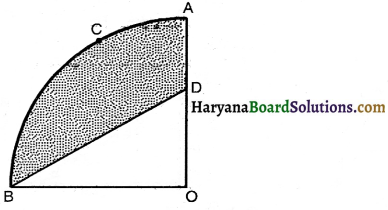
Solution.
We have,
Radius of a quadrant = 3.5 cm and OD = 2 cm
(i) Area of quadrant OACB = \(\frac{1}{4}\) × π × (3.5)2
= \(\frac{1}{4}\) × \(\frac{22}{7}\) × 35 × 35
= \(\frac{77}{8}\) cm2.
(ii) In right ∆BOD, we have OB = 35cm, and OD = 2 cm
Area of ∆OBD = \(\frac{1}{2}\) × 35 × 2
= 3.5 cm2 = \(\frac{7}{2}\) cm2
Area of shaded region= quadrant area – area of ∆BOD
= \(\frac{77}{8}-\frac{7}{2}\)
= \(\frac{77-28}{8}\)
= \(\frac{49}{8}\) cm2.
Hence, arei of quadrant = \(\frac{77}{8}\) cm2
and area of shaded region = \(\frac{49}{8}\) cm2.
Question 13.
In the given figure, a square OABC is inscribed in a quadrant OPBQ. If OA = 20 cm, find the area of the shaded region. (use π = 3.14)
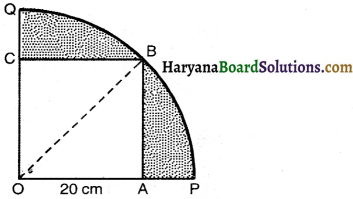
Solution:
We have,
Side of square (OA) = 20 cm
In right angle triangle OAB.
OB2 = OA2 + AB2 (By Pythagoras theorem)
OB2 = 202 + 202
OB2 = 400 + 400
OB2 = 800
OB = \(\sqrt{800}\) = 20√2 cm
∴ Radius of the quadrant 20√2 cm
Area of shaded region= Area of Quadrant – area of Square.
= \(\frac{1}{4}\) π × (20√2)2 – 20 × 20
= \(\frac{1}{4}\) × 3.14 × 800 – 400
= 628 – 400 = 228 cm2.
Hence, area of shaded region = 228 cm2.
![]()
Question 14.
AB and CD are respectively arcs of two concentric circles of radii 21 cm and 7 cm and centre O (see in figure). If ∠AOB = 30°, Find the area of the shaded region.
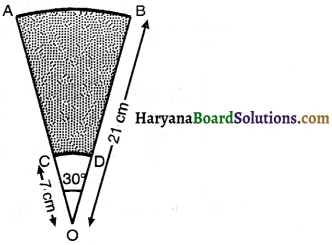
Solution.
We have,
Radius of sector AOB (r1) = 21 cm
Radius of sector COD (r2) = 7 cm
Area of shaded region= Area of sector AOB – Area of sector COD
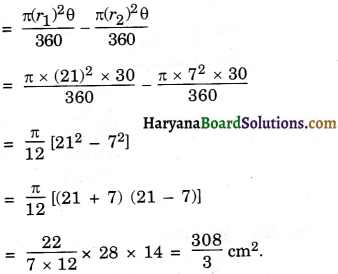
Hence, area of shaded region = \(\frac{308}{3}\) cm2.
Question 15.
In the given figure, ABC is a quadrant of a circle of radius 14 cm and a semicircle is drawn with BC as diameter. Find the area of the shaded region.
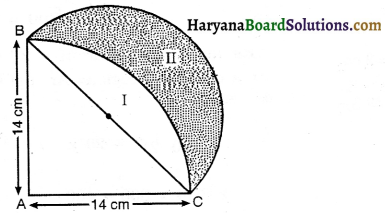
Solution:
We have,
Radius of a quadrant = 14 cm
In right ∆BAC,
BC2 = AB2 + AC2
BC2 = 142 + 142
BC2 = 2 × 142
BC = 14√2 cm
Area of region (I) = Area of quadrant ABC – Area of ∆ABC
= \(\frac{1}{4}\) π × 142 – \(\frac{1}{2}\) × 14 × 14
= \(\frac{1}{4}\) × \(\frac{22}{7}\) × 14 × 14 – 7 × 14
= 154 – 98 = 56 cm2.
Area of shaded region (II) = Area of the semicircle drawn on BC as diameter – Area of region I
= \(\frac{1}{2} \times \pi \times\left(\frac{14 \sqrt{2}}{2}\right)^2-56\)
= \(\frac{1}{2} \times \frac{22}{7} \times \frac{392}{4}\) – 56
= \(\frac{616}{4}\) – 56
= 154 – 56 = 98 cm2.
Hence, area of shaded region = 98 cm2.
![]()
Question 16.
Calculate the area of the designed region in given figure common between the two quadrants of circles of radius 8 cm each.
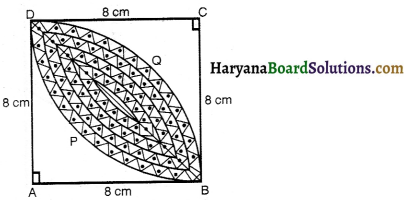
Solution:
We have,
Radius of the circle = 8 cm
Area of the designed region = 2 (Area of quadrant ∆BQD – Area of ∆ABD)
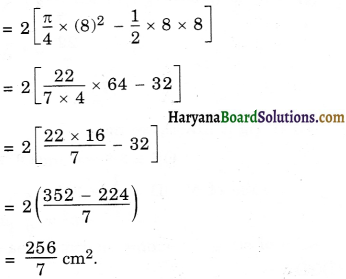
Hence, area of designed region = \(\frac{256}{7}\) cm2.